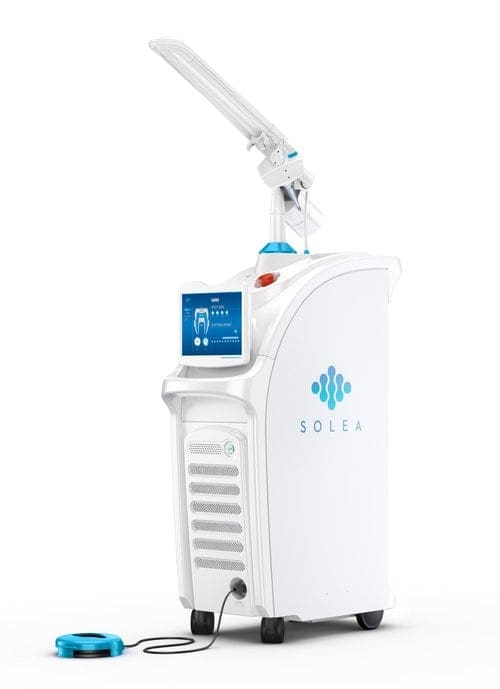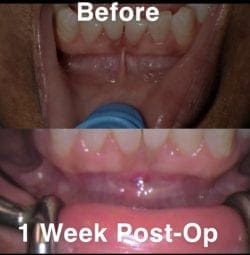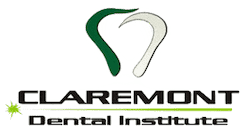Anesthesia-Free, Pain-Free, Suture-Free Dentistry
Dental lasers have changed dentistry by replacing the need for drills, anesthesia, and stitches. With laser dentistry, patients who might have needed major surgery can now get treatment that is less invasive and very effective, without long recovery times, swelling, or pain.
Almost 95% of patients who have laser treatments don’t need any anesthesia.
At Claremont Dental Institute, we use the Solea® laser to treat issues with the gums, enamel, dentin, and even bone. Dr. Steve Fountain and his team stay up-to-date with the latest dental technology. The Solea laser has greatly improved dental care, making it less invasive, more accurate, and providing a better experience for patients.
Claremont Dental Institute is at the forefront of a dental revolution. People all over the country have been pleasantly shocked after experiencing anesthesia-free and virtually pain-free procedures. The skilled practitioners at Claremont Dental Institute now deliver that experience to each one of their patients.”
— CEO Michael Cataldo – Convergent Dental
How does Solea work?

The Solea laser is FDA-approved and can treat both hard and soft tissue issues. It allows our dentists to work quickly, quietly, and without anesthesia. Solea is a special type of CO2 laser that works at a wavelength of 9.3 microns. This laser uses a very thin beam of light energy to reshape or remove oral tissue with precision.
Solea treatments are safe and work well for both kids and adults. The unique light energy lowers the risk of infection, while also making the treatment more comfortable and reducing swelling and bleeding.
Solea Sleep Laser Therapy
Solea Sleep laser therapy is a non-surgical and non-invasive treatment. This procedure uses laser energy on the soft tissues in the throat to improve airflow and reduce snoring. The laser targets the deep layers of tissue, focusing on the parts of the throat that vibrate during snoring.
This therapy helps shrink and firm these tissues, creating a smoother airway and better airflow. As a result, it reduces the vibrations that cause snoring, leading to a quieter sleep environment.
In most cases, this treatment can offer short-term relief from snoring, and it may also help with conditions like sleep apnea that contribute to snoring. To learn about our sleep apnea treatments, see Sleep Apnea.
Laser Dentistry & Dental Anxiety
Solea has transformed the way we care for patients with dental anxiety. Many of the things that make people afraid of the dentist are no longer an issue. This laser allows us to provide pain-free, quiet treatments without the need for a dental drill.
Laser dentistry often means procedures can be done without anesthesia for both hard and soft tissue. The Solea laser offers a natural numbing effect, so patients usually don’t even need a local anesthetic. This laser is also very precise and quick.
For patients who get anxious just being in the office, the shorter visits can help. And for those who are nervous about needles, laser dentistry lets them get the care they need without stress.
Solea is especially great for treating children. It’s common for kids to feel nervous about dental treatment, especially if they’ve had painful experiences before. With this laser, we can treat children faster, making them more comfortable with little to no pain.
At Claremont Dental Institute, our investment in modern technology, like the Solea Laser, sets us apart. This laser provides a completely different experience compared to the traditional drill. Patients can get the dental care they need and jump right back into their day. No anesthesia means you can get all your dental work done in one visit, making it easy to return to work or home without losing valuable time.
Laser Frenectomy

A laser frenectomy is a procedure where a dentist uses a laser to remove a frenulum, a small fold of tissue that can pull too tightly on the gums. This tightness can cause or worsen gum recession, leading to tooth loss. The CO2 laser is ideal for this procedure because it can both cut and stop bleeding in soft tissue.
The procedure is quick but usually requires a local anesthetic. Using a laser helps reduce bleeding, lowers the risk of infection after surgery, and minimizes complications. A few days after surgery, you might notice some white, possibly firm tissue at the surgical site. This is normal healing tissue. Full healing typically takes about one week.
This procedure is also common for children who have difficulty eating. If you think you or your child might need a frenectomy, call us at Claremont Dental Institute to schedule a consultation.
Laser Dentistry FAQs
Laser dentistry is one of the best advancements in modern dental technology. Learn more.
What is the Solea laser?
The Solea laser is a CO₂ dental laser that can treat both hard and soft tissues. It’s one of the few lasers capable of drilling teeth and cutting gums with high precision and minimal discomfort. Many Solea procedures don’t require anesthesia, needles, or drills. It’s popular for treating cavities, doing gum work, and even performing pediatric dentistry.
Does laser dentistry hurt?
Most patients report feeling little to no discomfort during laser procedures. Lasers are less invasive than traditional dental tools and often eliminate the need for drills or sutures. In many cases, we may not even need to use anesthesia. The laser seals nerve endings as it works, which helps reduce post-treatment pain and sensitivity.
Is laser dentistry suitable for children?
Yes, laser dentistry is especially beneficial for children because it’s less intimidating and often doesn’t require anesthesia or loud dental drills. Common pediatric uses include treating tongue-tie, lip-tie, cavities, and gum reshaping. The reduced discomfort and quicker healing make it ideal for younger patients. It also helps minimize dental anxiety in kids.
Are there any risks or side effects of laser dentistry?
Laser dentistry has a low risk of complications when performed by a qualified professional. Some patients may experience mild sensitivity, slight swelling, or temporary discomfort following the procedure. However, these side effects are typically minimal and short-lived. We will explain any potential risks based on the treatment you’re receiving.
Does dental insurance cover laser treatments?
It depends on the procedure and your specific insurance plan. Some insurance companies cover laser treatments if they are considered medically necessary, such as periodontal therapy. Cosmetic laser procedures may not be covered. It’s always best to check with your insurance provider beforehand.
Can lasers completely replace the dental drill?
In some cases, yes, but not all. Lasers are excellent for treating small to moderate cavities and soft tissue procedures. However, complex restorations or procedures involving metal fillings may still require traditional tools. Your dentist will decide which method is most appropriate based on your needs.
For more details on the pros and cons of laser dentistry, it’s best to talk to our dentists during your regular check-up. With the right dental team, you can be sure you’re getting top-quality care.
